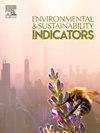Geosystem services from the subsurface: A literature review and a proposed set of indicators tailored to a Swedish setting
IF 5.4
Q1 ENVIRONMENTAL SCIENCES
引用次数: 0
Abstract
In this study, a literature review was conducted to identify indicators that can be utilised to assess and visualise the potential of the geophysical environment to deliver geosystem services. The literature review identified 24 studies and 22 technical reports, resulting in a list of 75 geosystem services indicators for 23 geosystem services associated with the subsurface. Building upon these findings, a country-specific set of 21 indicators pertinent to the geological setting of Sweden was developed. Each developed indicator was further subdivided into different ‘capacity classes’ to denote the potential of the geophysical environment to deliver a specific geosystem service. Most of these proposed indicators can be directly applied (19 out of 21), as there is readily available information in open-access maps and databases. However, some of the assigned capacity classes need to be adjusted according to the spatial scale of application. Furthermore, to convey the benefit or value of a given geosystem service, the proposed indicators must also be complemented with estimates of accessibility and societal importance of said service. Nonetheless, the proposed set of indicators represents an initial step towards a comprehensive mapping of geosystem services that can be used to highlight the multitude of ways the subsurface contributes to society.
求助全文
约1分钟内获得全文
求助全文
来源期刊

Environmental and Sustainability Indicators
Environmental Science-Environmental Science (miscellaneous)
CiteScore
7.80
自引率
2.30%
发文量
49
审稿时长
57 days
 求助内容:
求助内容: 应助结果提醒方式:
应助结果提醒方式:


